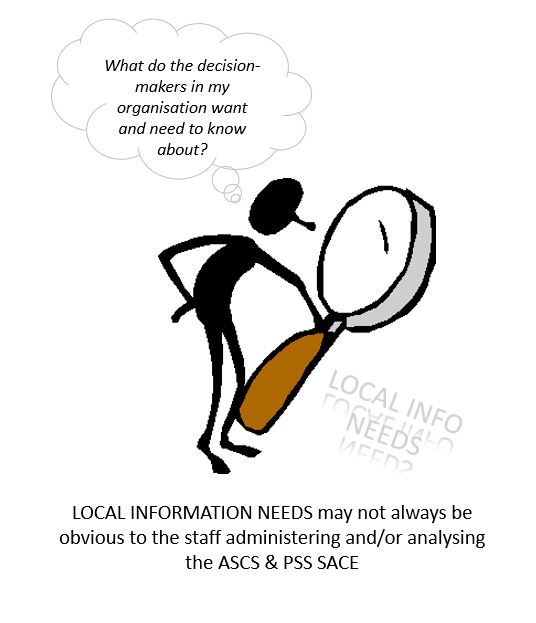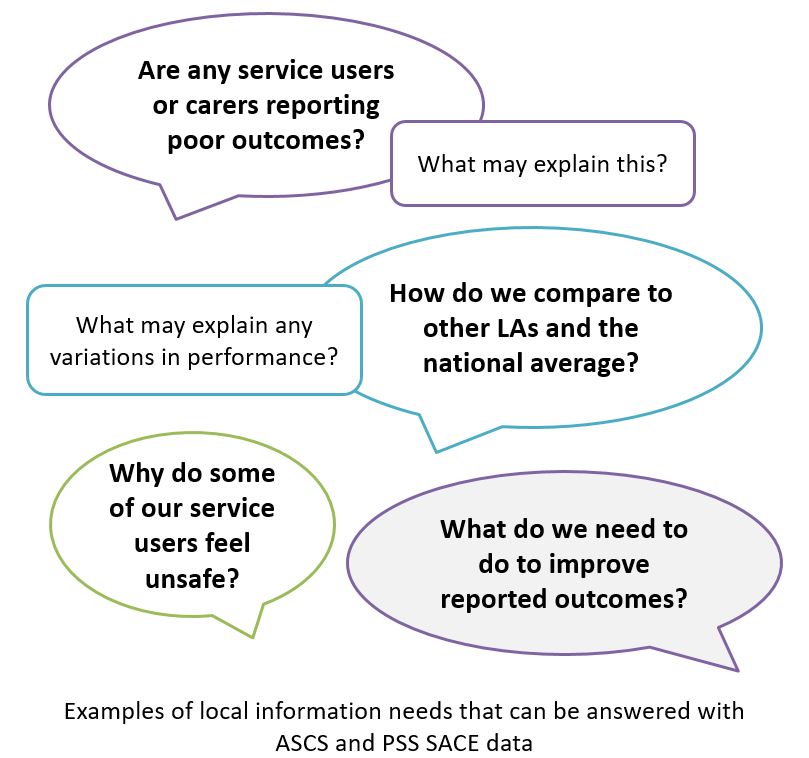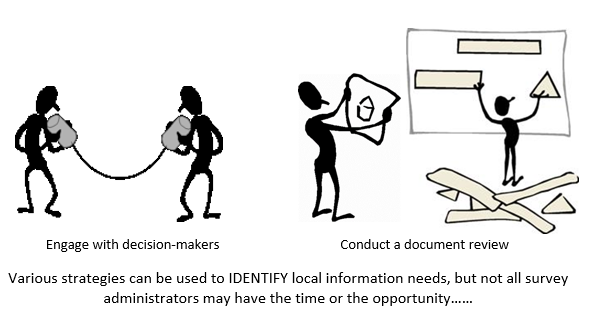IDENTIFYING LOCAL INFORMATION NEEDS
NHS Digital describe user-experience surveys, such as the ASCS and PSS SACE, as “the most significant pool of personal outcome information for people receiving adult social care”[i] and  encourage local authorities (LAs) to use the data collected by the surveys to guide the design and delivery of local services.
encourage local authorities (LAs) to use the data collected by the surveys to guide the design and delivery of local services.
While modifications to the survey or sample frame and focused analysis can be used to improve the local relevance and value of ASCS and PSS SACE data how do the staff administering the surveys figure out which questions to add and/or what types of analysis to carry out?
The IDENTIFICATION OF LOCAL INFORMATION NEEDS will help to guide these planning activities. It is the first step to transforming the ASCS and PSS SACE into a large piece of local research.

Local information needs are the kinds of data that decision-makers and practitioners in your organisation need to guide the design and delivery of the adult social care services they provide, and can often be fulfilled using survey data.
Many survey administrators and analysts involved in our earlier project work, however, reported difficulties with identifying local information needs. The MAX PLANNING GUIDE therefore outlines several possible strategies.
The quickest and most assured method is to ASK! Speaking directly to the decision-makers and practitioners who may be able to use the findings of ASCS or PSS SACE analysis to inform their day-to-day and longer-term work (e.g. at a senior management team meeting) is the simplest way to identify local information needs.
Examples of LA practice
An analyst in one LA attended a senior management team several months prior to the circulation of the ASCS and found out that managers were interested in knowing whether their plans to switch to an online complaints system would be favourably received by services users. Additional questions added to the survey subsequently uncovered a majority preference for the current telephone-based system.
Discussions in another LA highlighted an interest in assessing the awareness of a newly implemented service for carers. An additional question added to the PSS SACE subsequently found that nearly 70% of respondents did not know about the service, which suggested that further promotional was required.
Please see the LA practice summary for further examples.
Engaging with the relevant people, however, is not always possible. An alternative method is to CONDUCT A DOCUMENT REVIEW and extract local information needs from current strategy reports (e.g. JSNAs) and previous survey reports.
Example of LA practice
An analyst in one LA reviewed the findings from a local survey and noted a higher incident of service users feeling unsafe than recorded in the previous ASCS. In order to explore this discrepancy and identify possible explanations, the analysts (with permission from their LA colleagues and NHS Digital) added a multiple choice question and comments box after the existing safety question. Further analysis of respondent comments found that many service users felt unsafe due to a general fear of neighbourhood crime and falling (e.g. in their homes or outside).
Please see the LA practice summary for further examples.
The MAX project team do appreciate that some survey administrators and analysts may not have the time nor the opportunity to take up these approaches. Rather than resorting to producing lengthy reports of all analysis findings, an approach that many of the report-recipients we spoke to did not find useful, we would suggest that analysts REFER TO THE GENERAL LOCAL INFORMATION NEEDS IDENTIFIED DURING OUR EARLIER RESEARCH ACTIVITIES AND CONSULTATIONS. These information needs are summarised in the MAX PLANNING GUIDE, and further guidance on how to fulfil them is provided in the analysis and reporting elements of the MAX toolkit.
There are a number of strategies that you can use to identify the local information needs and the most appropriate approach will depend on the time, resources and opportunities available to you. Whichever strategy you use will certainly help you to improve the local relevance and value of your survey data, so take a look at the MAX Planning guide and see how it may help.
_______________________________________________________
Disclaimers
This blog is based on independent research commissioned and funded by the NIHR Policy Research Programme (Maximising the value of survey data in adult social care (MAX) project and MAX toolkit implementation and impact study). The views expressed in the publication are those of the author(s) and not necessarily those of the NHS, the NIHR, the Department of Health and Social Care or its arm’s length bodies or other government departments.
[i] https://digital.nhs.uk/data-and-information/data-collections-and-data-sets/data-collections/social-care-user-surveys

Trackbacks/Pingbacks
[…] earlier blog described how you can identify the information needs of decision-makers and practitioners in […]